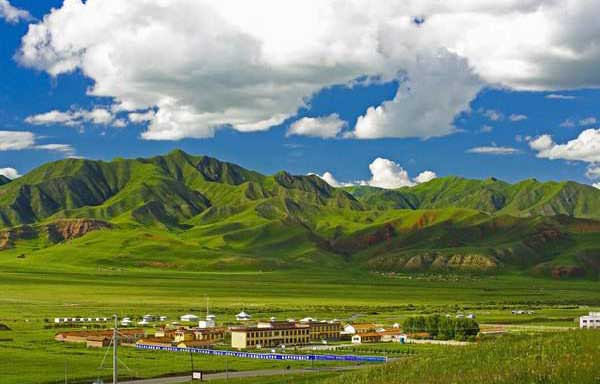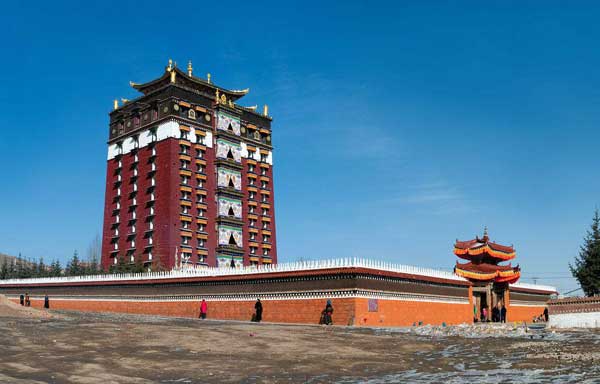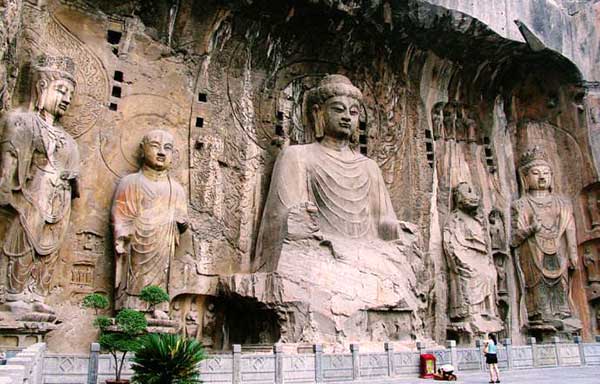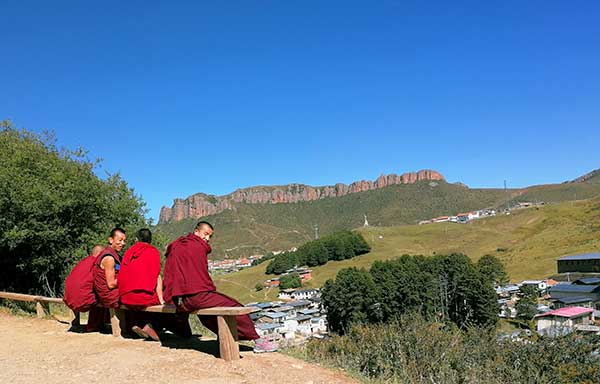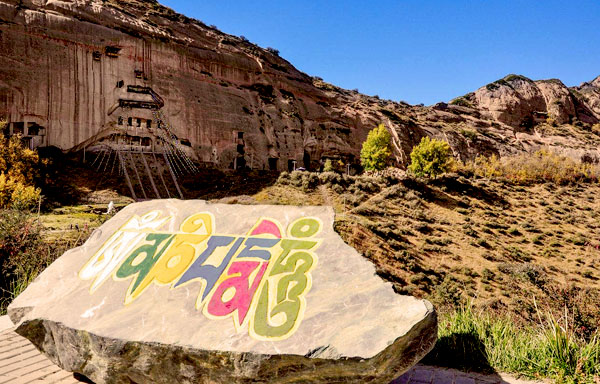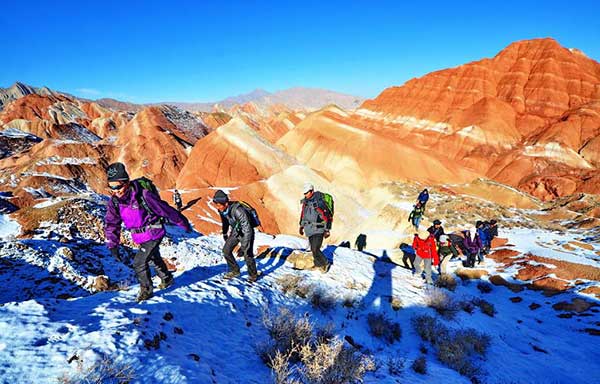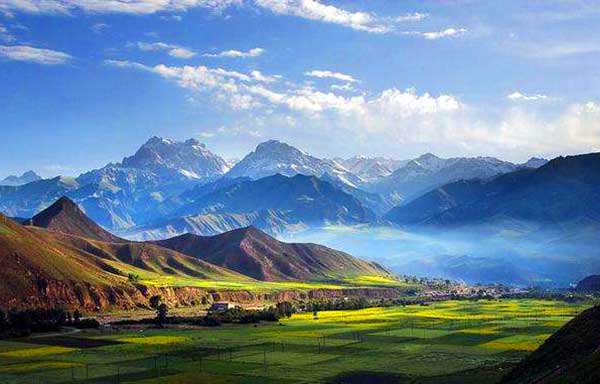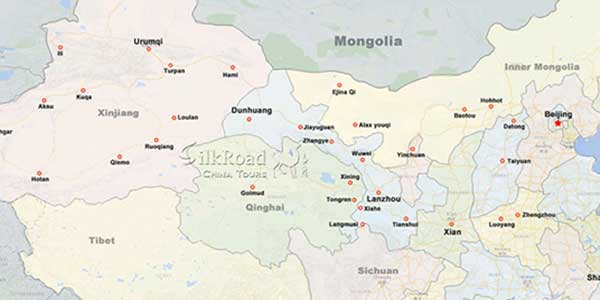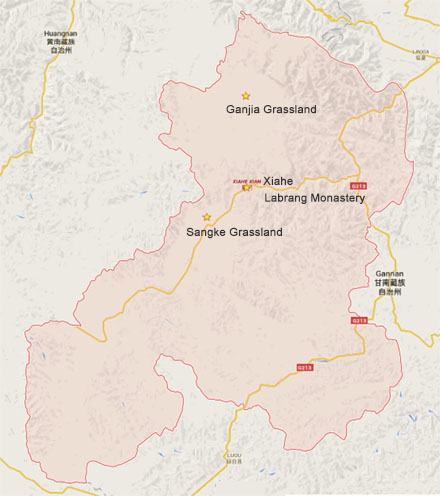 The Labrang Monastery is located at the foot of the Phoenix Mountain northwest of Xiahe County in Gannan Tibetan Nationality Autonomous Prefecture, Gansu Province. A propitious place in the hearts of the Tibetan, it stands by the Daxia River and faces the Dragon Mountain.
The Labrang Monastery is located at the foot of the Phoenix Mountain northwest of Xiahe County in Gannan Tibetan Nationality Autonomous Prefecture, Gansu Province. A propitious place in the hearts of the Tibetan, it stands by the Daxia River and faces the Dragon Mountain.
As for the Dragon and Phoenix Mountains, there is a beautiful legend. A long time ago, this place was a boundless sea. After countless changes, mountains and lands appeared. One day, a golden-wing phoenix flew here and rested on one of the mountains in the south. It was so thirsty that it drank all the water; thus the sea dried up. A dragon in the sea was greatly shocked, so it cavorted out of the water, which led to the emergence of a spring at the site where the phoenix drank. As the spring water effused more and more, the Daxia River was formed. So the dragon became the Dragon Mountain and the phoenix became the Phoenix Mountain. And the Daxia River flowed from west to east through the two mountains, eroding the hollow into a basin. The Labrang Monastery was built on the Zhaxiqi (means auspiciousness) shoal which is in the north of the basin.
The architectural layout of the Labrang Monastery belongs to the Tibetan style and the construction patterns are mostly Tibetan, Han's mode and a compound style of both Han's and Tibetan. The symbols of the whole construction are the White Towers both in the northeast and in the northwest. The grand sutra and Buddha halls are located in the northwestern part centered around the Grand Sutra Hall. Other halls spread in a shape similar to a crescent moon.
The Grand Sutra Hall is the dominant place for the religious activities of the Labrang Monastery and for the adherents' worshipping. On the inside walls there are portraits of Buddha and built-in shrines of Buddha and bookcases. The elegantly decorated hall is splendid enough to give you real enjoyment.
Located in the northwest of the Grand Sutra Hall, the Grand Golden Tile Hall is the highest building in the Labrang Monastery and is strongly tinged with a Nepalese flavor. It is six-storied and the roof is covered with bronze bricks that are washed by gold. In front of the hall gate, a stele hangs on which the Han, Tibetan, Manchu and Mongolian characters were written by the Emperor Jiaqing (1760-1820) of the Qing Dynasty (1644-1911). Inside the hall there is a bronze figure of Buddha created by Nepalese artisans.
The Labrang Monastery boasts tens of thousands of statues of Buddha made of gold, silver, copper, and aluminum. There are statues with ivory, sandalwood, jade, crystal and clay as the basic materials. These Buddha statues are all lifelike with kind-looking faces, which give you a real enjoyment of beauty. In addition, the monastery possesses many Buddha hats and many Buddhist treasures adorned with pearls, jadeite, agate and diamonds.
The Labrang Monastery holds seven large-scale summon ceremonies a year, among which the Summons Ceremony in the first lunar month and the Buddhist Doctrine Explaining Ritual in the seventh lunar month are the grandest ones.
Gallery
Attractions in the area
Related Tours
General Information
Alias: No
Loc: In Xiahe city
Entrance: 40 RMB
Open Time: 8:00-18:00
Relevant blogs
-
How did the name of Tianshui in Gansu come about?
The name Tianshui is very pleasant to the ear, and it reminds one of that exquisitely beautiful verse, "After getting drunk, one doesn't know if the sky is in
-
The 8th Silk Road Hotel Festival was successfully held i
On December 27th, the "8th Silk Road Hotel Festival" grandly opened at the Yujing International Hotel in Zhangye. This hotel festival gathered industry experts,
-
The Karez Irrigation System in Turpan has been selected
On September 3rd, at the 75th Executive Council Meeting of the International Commission on Irrigation and Drainage held in Sydney, Australia, the 2024 (11th bat
-
What is the connection between "dragons" and "snakes
In traditional Chinese culture, the snake has a dual identity of auspiciousness and danger. Ancient people believed that the snake not only possesses divine cha
-
Endangered Przewalski's Horses Spotted at Dunhuang Yume
<p>In early February, a group of special "visitors"—the Przewalski's horses—appeared at the Dunhuang Yumen Pass scenic area in Gansu Province, a U
-
The Fourth Dunhuang Cultural Tourism Supplier Conference
On the morning of February 18th, the Fourth Dunhuang Cultural Tourism Supplier Conference in Northwest China commenced at the Dunhuang International Convention






